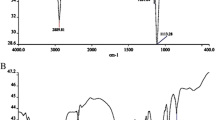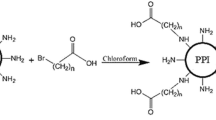Abstract
The applications of dendrimer-based vectors seem to be promising in non-viral gene delivery because of their potential for addressing the problems with viral vectors. In this study, generation 3 poly(propyleneimine) (G3-PPI) dendrimers with 1, 4-diaminobutane as a core initiator was synthesized using a divergent growth approach. To increase the hydrophobicity and reduce toxicity, 10% of primary amines of G3-PPI dendrimers were replaced with bromoalkylcarboxylates with different chain lengths (6-bromohexanoic and 10-bromodecanoic). Then, to retain the overall buffering capacity and enhance transfection, the alkylcarboxylate–PPIs were conjugated to 10 kDa branched polyethylenimine (PEI). The results showed that the modified PPI was able to form complexes with the diameter of less than 60 nm with net-positive surface charge around 20 mV. No significant toxicity was observed in modified PPIs; however, the hexanoate conjugated PPI–PEI (PPI-HEX-10% PEI) and the decanoate conjugated PPI–PEI (PPI-DEC-10%-PEI) showed the best transfection efficiency in murine neuroblastoma (Neuro-2a) cell line, even PPI-HEX-10%-PEI showed transfection efficiency equal to standard PEI 25 kDa with reduced toxicity. This study suggested a new series of hyperbranched (PEI)–dendrimer (PPI) architectural copolymers as non-viral gene delivery vectors with high transfection efficiency and low toxicity.

A schematic representative of hyperbranched PEI conjugated to poly(propyleneimine) dendrimers








Similar content being viewed by others
References
Aldawsari H, Edrada-Ebel R, Blatchford DR, Tate RJ, Tetley L, Dufes C (2011) Enhanced gene expression in tumors after intravenous administration of arginine-, lysine- and leucine-bearing polypropylenimine polyplex. Biomaterials 32:5889–5899. doi:10.1016/j.biomaterials.2011.04.079
Allon N, Saxena A, Chambers C, Doctor BP (2012) A new liposome-based gene delivery system targeting lung epithelial cells using endothelin antagonist. J Control Release 160:217–224. doi:10.1016/j.jconrel.2011.10.033
Askarian S, Abnous K, Taghavi S, Oskuee RK, Ramezani M (2015) Cellular delivery of shRNA using aptamer-conjugated PLL-alkyl-PEI nanoparticles. Colloids Surf B: Biointerfaces 136:355–364. doi:10.1016/j.colsurfb.2015.09.023
Ayatollahi S et al (2015a) Synthesis of efficient gene delivery systems by grafting pegylated alkylcarboxylate chains to PAMAM dendrimers: evaluation of transfection efficiency and cytotoxicity in cancerous and mesenchymal stem cells. J Biomater Appl 30:632–648. doi:10.1177/0885328215599667
Ayatollahi S et al (2015b) Synthesis of efficient gene delivery systems by grafting pegylated alkylcarboxylate chains to PAMAM dendrimers: evaluation of transfection efficiency and cytotoxicity in cancerous and mesenchymal stem cells. J Biomater Appl 30:632–648. doi:10.1177/0885328215599667
Boas U, Karlsson AJ, de Waal BF, Meijer EW (2001) Synthesis and properties of new thiourea-functionalized poly(propylene imine) dendrimers and their role as hosts for urea functionalized guests. J Org Chem 66:2136–2145
Breunig M, Lungwitz U, Liebl R, Goepferich A (2007) Breaking up the correlation between efficacy and toxicity for nonviral gene delivery. Proc Natl Acad Sci U S A 104:14454–14459
Calderón M, Quadir MA, Strumia M, Haag R (2010) Functional dendritic polymer architectures as stimuli-responsive nanocarriers. Biochimie 92:1242–1251. doi:10.1016/j.biochi.2010.02.017
Cheng Y, Wu Q, Li Y, Xu T (2008a) External electrostatic interaction versus internal encapsulation between cationic dendrimers and negatively charged drugs: which contributes more to solubility enhancement of the drugs? J Phys Chem B 112:8884–8890
Cheng Y, Xu Z, Ma M, Xu T (2008b) Dendrimers as drug carriers: applications in different routes of drug administration. J Pharm Sci 97:123–143. doi:10.1002/jps.21079
Choi JS, Nam K, Park JY, Kim JB, Lee JK, Park JS (2004) Enhanced transfection efficiency of PAMAM dendrimer by surface modification with L-arginine. J Control Release 99:445–456
Choi JS, Ko KS, Park JS, Kim YH, Kim SW, Lee M (2006) Dexamethasone conjugated poly(amidoamine) dendrimer as a gene carrier for efficient nuclear translocation. Int J Pharm 320:171–178
de Brabander-van den Berg E, Meijer E (1993) Poly (propylene imine) dendrimers: large-scale synthesis by hetereogeneously catalyzed hydrogenations. Angew Chem Int Ed Engl 32:1308–1311
Dehshahri A, Oskuee RK, Shier WT, Hatefi A, Ramezani M (2009) Gene transfer efficiency of high primary amine content, hydrophobic, alkyl-oligoamine derivatives of polyethylenimine. Biomaterials 30:4187–4194
Dehshahri A, Oskuee RK, Ramezani M (2012a) Plasmid DNA delivery into hepatocytes using a multifunctional nanocarrier based on sugar-conjugated polyethylenimine. Gene Ther Mol Biol 14:62–71
Dehshahri A, Oskuee RK, Shier WT, Ramezani M (2012b) β-Galactosylated alkyl-oligoamine derivatives of polyethylenimine enhanced pDNA delivery into hepatic cells with reduced toxicity. Curr Nanosci 8:548–555
El-Sayed M, Ginski M, Rhodes C, Ghandehari H (2002) Transepithelial transport of poly(amidoamine) dendrimers across Caco-2 cell monolayers. J Control Release 81:355–365
Fischer D, Li Y, Ahlemeyer B, Krieglstein J, Kissel T (2003) In vitro cytotoxicity testing of polycations: influence of polymer structure on cell viability and hemolysis. Biomaterials 24:1121–1131
Gholami L, Sadeghnia HR, Darroudi M, Kazemi Oskuee R (2014) Evaluation of genotoxicity and cytotoxicity induced by different molecular weights of polyethylenimine/DNA nanoparticles. Turk J Biol 38:380–387. doi:10.3906/biy-1309-51
Ginn SL, Alexander IE, Edelstein ML, Abedi MR, Wixon J (2013) Gene therapy clinical trials worldwide to 2012—an update. J Gene Med 15:65–77. doi:10.1002/jgm.2698
Hu W et al (2014) Redox and pH-responsive poly (amidoamine) dendrimer-poly (ethylene glycol) conjugates with disulfide linkages for efficient intracellular drug release. Colloids Surf B Biointerfaces 123:254–263. doi:10.1016/j.colsurfb.2014.09.024
Jain K, Kesharwani P, Gupta U, Jain NK (2010) Dendrimer toxicity: Let’s meet the challenge. Int J Pharm 394:122–142. doi:10.1016/j.ijpharm.2010.04.027
Jevprasesphant R, Penny J, Jalal R, Attwood D, McKeown NB, D'Emanuele A (2003) The influence of surface modification on the cytotoxicity of PAMAM dendrimers. Int J Pharm 252:263–266
Kim TI, Baek JU, Zhe Bai C, Park JS (2007) Arginine-conjugated polypropylenimine dendrimer as a non-toxic and efficient gene delivery carrier. Biomaterials 28:2061–2067
Kloeckner J, Bruzzano S, Ogris M, Wagner E (2006) Gene carriers based on hexanediol diacrylate linked oligoethylenimine: effect of chemical structure of polymer on biological properties. Bioconjug Chem 17:1339–1345
Kunath K, von Harpe A, Fischer D, Petersen H, Bickel U, Voigt K, Kissel T (2003) Low-molecular-weight polyethylenimine as a non-viral vector for DNA delivery: comparison of physicochemical properties, transfection efficiency and in vivo distribution with high-molecular-weight polyethylenimine. J Control Release 89:113–125
Lee CC, MacKay JA, Frechet JM (2005) Szoka FC. Designing dendrimers for biological applications Nat Biotechnol 23:1517–1526
Lim Y et al (2001) Cationic hyperbranched poly(amino ester): a novel class of DNA condensing molecule with cationic surface, biodegradable three-dimensional structure, and tertiary amine groups in the interior. J Am Chem Soc 123:2460–2461
Liu Q, Muruve DA (2003) Molecular basis of the inflammatory response to adenovirus vectors. Gene Ther 10:935–940
Liu H, Wang Y, Wang M, Xiao J, Cheng Y (2014) Fluorinated poly(propylenimine) dendrimers as gene vectors. Biomaterials 35:5407–5413. doi:10.1016/j.biomaterials.2014.03.040
Mahmoudi A, Oskuee RK, Ramezani M, Malaekeh-Nikoue B (2014) Preparation and in-vitro transfection efficiency evaluation of modified cationic liposome-polyethyleneimine-plasmid nanocomplexes as a novel gene carrier. Current Drug Delivery 11:636–642
Malaekeh-Nikouei B, Malaekeh-Nikouei M, Oskuee RK, Ramezani M (2009) Preparation, characterization, transfection efficiency, and cytotoxicity of liposomes containing oligoamine-modified cholesterols as nanocarriers to Neuro2A cells. Nanomedicine: Nanotechnology, Biology, and Medicine 5:457–462. doi:10.1016/j.nano.2009.02.001
Martinho N, Florindo H, Silva L, Brocchini S, Zloh M, Barata T (2014) Molecular modeling to study dendrimers for biomedical applications. Molecules 19:20424–20467. doi:10.3390/molecules191220424
Nimesh S, Aggarwal A, Kumar P, Singh Y, Gupta KC, Chandra R (2007) Influence of acyl chain length on transfection mediated by acylated PEI nanoparticles. Int J Pharm 337:265–274
Oskuee RK, Dehshahri A, Shier WT, Ramezani M (2009) Alkylcarboxylate grafting to polyethylenimine: a simple approach to producing a DNA nanocarrier with low toxicity. J Gene Med 11:921–932
Oskuee RK, Mohtashami E, Golami L, Malaekeh-Nikouei B (2014) Cationic liposomes-polyallylamine-plasmid nanocomplexes for gene delivery. J Exp Nanosci 9:1026–1034. doi:10.1080/17458080.2013.771245
Oskuee RK, Dosti F, Gholami L, Malaekeh-Nikouei B (2015) A simple approach for producing highly efficient DNA carriers with reduced toxicity based on modified polyallylamine. Mater Sci Eng C 49:290–296. doi:10.1016/j.msec.2015.01.016
Paleos CM, Tsiourvas D, Sideratou Z (2007) Molecular engineering of dendritic polymers and their application as drug and gene delivery systems. Mol Pharm 4:169–188. doi:10.1021/mp060076n
Parhiz H, Hashemi M, Hatefi A, Shier WT, Amel Farzad S, Ramezani M (2013) Arginine-rich hydrophobic polyethylenimine: potent agent with simple components for nucleic acid delivery. Int J Biol Macromol 60:18–27. doi:10.1016/j.ijbiomac.2013.05.001
Park SC, Nam JP, Kim YM, Kim JH, Nah JW, Jang MK (2013) Branched polyethylenimine-grafted-carboxymethyl chitosan copolymer enhances the delivery of pDNA or siRNA in vitro and in vivo. Int J Nanomedicine 8:3663–3677. doi:10.2147/IJN.S50911
Paul A, Eun C-J, Song JM (2014) Cytotoxicity mechanism of non-viral carriers polyethylenimine and poly-l-lysine using real time high-content cellular assay. Polymer 55:5178–5188. doi:10.1016/j.polymer.2014.08.043
Pednekar PP, Jadhav KR, Kadam VJ (2012) Aptamer-dendrimer bioconjugate: a nanotool for therapeutics, diagnosis, and imaging. Expert Opinion on Drug Delivery 9:1273–1288. doi:10.1517/17425247.2012.716421
Rekha MR, Sharma CP (2011) Hemocompatible pullulan-polyethyleneimine conjugates for liver cell gene delivery: in vitro evaluation of cellular uptake, intracellular trafficking and transfection efficiency. Acta Biomater 7:370–379. doi:10.1016/j.actbio.2010.07.027
Russ V, Gunther M, Halama A, Ogris M, Wagner E (2008) Oligoethylenimine-grafted polypropylenimine dendrimers as degradable and biocompatible synthetic vectors for gene delivery. J Control Release 132:131–140. doi:10.1016/j.jconrel.2008.09.003
Schatzlein AG et al (2005) Preferential liver gene expression with polypropylenimine dendrimers. J Control Release 101:247–258
Sun JY, Anand-Jawa V, Chatterjee S, Wong KK (2003) Immune responses to adeno-associated virus and its recombinant vectors. Gene Ther 10:964–976. doi:10.1038/sj.gt.3302039
Svenson S, Tomalia DA (2005) Dendrimers in biomedical applications—reflections on the field. Adv Drug Deliv Rev 57:2106–2129
Tack F et al (2006) Modified poly(propylene imine) dendrimers as effective transfection agents for catalytic DNA enzymes (DNAzymes). J Drug Target 14:69–86
Takahashi T, Kono K, Itoh T, Emi N, Takagishi T (2003) Synthesis of novel cationic lipids having polyamidoamine dendrons and their transfection activity. Bioconjug Chem 14:764–773
Taratula O et al (2009) Surface-engineered targeted PPI dendrimer for efficient intracellular and intratumoral siRNA delivery. J Control Release 140:284–293. doi:10.1016/j.jconrel.2009.06.019
Tziveleka LA, Psarra AM, Tsiourvas D, Paleos CM (2007) Synthesis and characterization of guanidinylated poly(propylene imine) dendrimers as gene transfection agents. J Control Release 117:137–146. doi:10.1016/j.jconrel.2006.10.019
Verma IM, Somia N (1997) Gene therapy—promises, problems and prospects. Nature 389:239–242
Yoo H, Juliano RL (2000) Enhanced delivery of antisense oligonucleotides with fluorophore-conjugated PAMAM dendrimers. Nucleic Acids Res 28:4225–4231
Zinselmeyer BH, Mackay SP, Schatzlein AG, Uchegbu IF (2002) The lower-generation polypropylenimine dendrimers are effective gene-transfer agents. Pharm Res 19:960–967
Acknowledgements
This work was founded by the National Science Foundation (INSF) (Grant number 91002289). The financial support by Mashhad University of Medical Sciences is also acknowledged. This study was a part of the MSc thesis of S. J. Alavi.
Author information
Authors and Affiliations
Corresponding author
Ethics declarations
Conflict of interest
The authors declare that they have no conflict of interest.
Electronic supplementary material
ESM 1
(DOCX 951 kb)
Rights and permissions
About this article
Cite this article
Alavi, S.J., Gholami, L., Askarian, S. et al. Hyperbranched–dendrimer architectural copolymer gene delivery using hyperbranched PEI conjugated to poly(propyleneimine) dendrimers: synthesis, characterization, and evaluation of transfection efficiency. J Nanopart Res 19, 49 (2017). https://doi.org/10.1007/s11051-017-3739-4
Received:
Accepted:
Published:
DOI: https://doi.org/10.1007/s11051-017-3739-4




